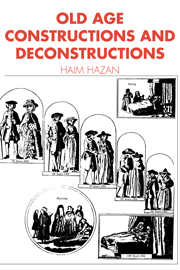Book contents
- Frontmatter
- Contents
- Acknowledgements
- Introduction: towards knowledge of old age
- PART I REPRESENTATIONS OF AGEING: LANGUAGES ABOUT OLD AGE
- 1 The social trap: the language of separation
- 2 The cultural trap: the language of images
- 3 The personal trap: the language of self-presentation
- 4 The theoretical trap: the missing language
- PART II PRESENTATIONS OF AGEING: LANGUAGES OF THE OLD
- Conclusions: the nature of knowledge about ageing
- Notes
- Bibliography
- Index
1 - The social trap: the language of separation
Published online by Cambridge University Press: 05 June 2012
- Frontmatter
- Contents
- Acknowledgements
- Introduction: towards knowledge of old age
- PART I REPRESENTATIONS OF AGEING: LANGUAGES ABOUT OLD AGE
- 1 The social trap: the language of separation
- 2 The cultural trap: the language of images
- 3 The personal trap: the language of self-presentation
- 4 The theoretical trap: the missing language
- PART II PRESENTATIONS OF AGEING: LANGUAGES OF THE OLD
- Conclusions: the nature of knowledge about ageing
- Notes
- Bibliography
- Index
Summary
Everyday rhetorics reflect spheres of taken-for-granted knowledge about the world. That knowledge, symbolically expressed and interactively maintained, preserves social boundaries and cultural classifications. The nomenclature of ageing is a device for introducing order into an inherently ambiguous human condition. Designed to make meaningful the meaningless and describe the indescribable, it uses codes of sequestration and separation to construct a wall around ageing. Thus, while facilitating communication by creating shared attitudes, it also serves to perpetuate misunderstanding.
The term ‘aged’ not only describes individuals but also is used as a collective noun, and once individuals are identified as ‘old’ they are perceived exclusively as such. Even the alternative terms, sometimes used to soften the negative connotations of the word ‘old’, ‘the elderly’, ‘older persons’, ‘senior citizens’, ‘elders’ or ‘old age pensioners’ – all serve to stigmatize the aged. Such linguistic generalizations cannot be justified on either logical or empirical grounds. The label ‘old’ may be used, for example, to describe both persons in their sixties who are still physically active and fully capable of functioning in every respect and patients in a geriatric ward. Assigning these two types of persons to the same category may not involve any conscious decision, but it is part of a complex cultural process which operates through the medium of language. Language, which functions as a reality-constructing device, sets boundaries for our universe of imagery and associations and fuses concepts, myths and symbols into accepted forms of communication.
- Type
- Chapter
- Information
- Old AgeConstructions and Deconstructions, pp. 13 - 27Publisher: Cambridge University PressPrint publication year: 1994

